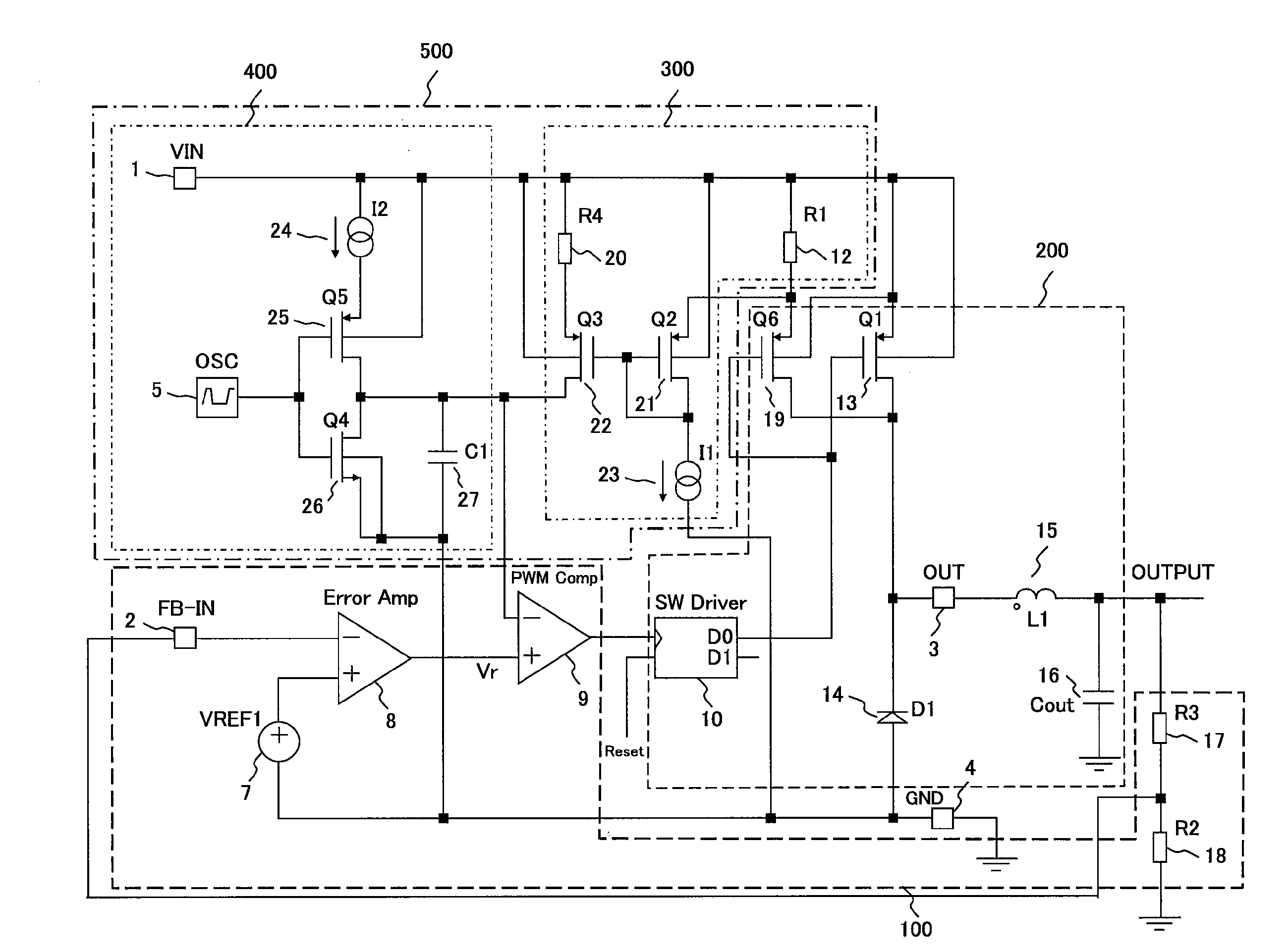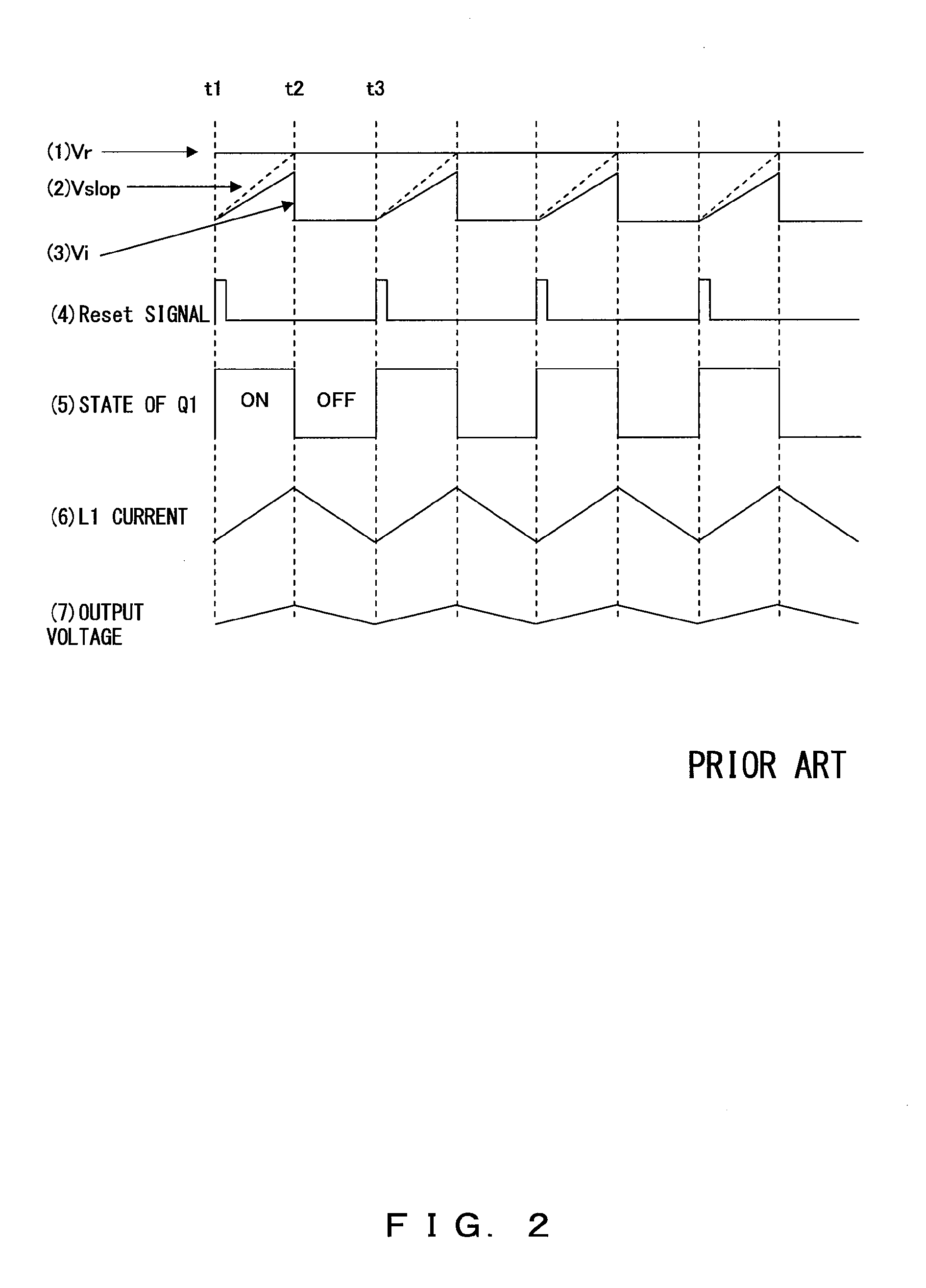Current negative-feedback circuit and dc-dc converter using the circuit
a negative-feedback circuit and current-feedback technology, applied in the direction of dc-dc conversion, power conversion systems, instruments, etc., can solve the problems of difficult to solve oscillation problems, affecting control operations, and the inability to use mask signal methods for recent dc-dc converters, etc., to achieve the effect of reducing the manufacturing cost of an ic, speeding up the current negative-feedback circuit, and reducing the influence of on/off noise o
- Summary
- Abstract
- Description
- Claims
- Application Information
AI Technical Summary
Benefits of technology
Problems solved by technology
Method used
Image
Examples
first preferred embodiment
[0034]FIG. 5 shows the first preferred embodiment of a current negative-feedback circuit and a DC-DC converter using the circuit, according to the preferred embodiment of the present invention. In FIG. 5, the same reference numerals are attached to components common to those illustrated in FIG. 1. As in FIG. 1, the Error Amp 8, the reference voltage VREF1 (7), the PWM Comp 9 and the resistors R3 (17) and R2 (18) constitute the FB control unit 100, and the SW driver 10, the switching devices Q1 (13) and Q6 (19), the inductor L1 (15), the diode D1 (14), and the output capacitor Cout 16 constitute the output generation unit 200.
[0035]In FIG. 5, a constant current source I2 (24), a P-ch MOSFET Q5 (25) that is the first switching device and that becomes a charge route to a capacitor C1 (27), an N-ch MOSFET Q4 (26) that is the second switching device and that becomes a discharge route to a capacitor C1 (27), and a capacitor C1 (27) constitute a sawtooth-shaped waveform generation unit 400...
second preferred embodiment
[0055]FIG. 6 shows the second preferred embodiment of a current negative-feedback circuit and a DC-DC converter using the circuit, according to the preferred embodiment of the present invention, in which the switching device Q1 (13) illustrated in FIG. 5 is composed of an N-ch MOSFET instead of the P-ch MOSFET. In FIG. 6, the same reference numerals are attached to components common to those in FIG. 5. The Error Amp 8, the reference voltage VREF1 (7), the PWM Comp 9, and the resistors R3 (17) and R2 (18) constitute the FB control unit 100, and the SW Driver 10, the switching device Q1 (13) composed of an N-ch MOSFET, the inductor L1 (15), the diode D1 (14), and the output capacitor Cout 16 constitute the output generation unit 220, which is almost the same as in FIG. 5. As in FIG. 5, the current detection unit 300 and the sawtooth-shaped waveform generation unit 400 constitute the current negative-feedback circuit 500 according to the preferred embodiment of the present invention.
[0...
third preferred embodiment
[0057]In the second preferred embodiment illustrated in FIG. 6, as described above, it is feared that since the inductance current IL1 is large, the value of the current detection resistor R1 (12) will be so small that it will be difficult to manufacture it as an IC. Therefore, in the third preferred embodiment of a current negative-feedback circuit and a DC-DC converter using the circuit according to the preferred embodiment of the present invention illustrated in FIG. 7, a switching device Q6 (19), which is the same as the switching device Q1 (13) except that it has a gate width of 1 / N that of the switching device Q1 (13), is connected to the switching device Q1 (13) in parallel (their gates and sources are commonly connected), the current detection resistor R1 (12) is inserted between the drain of the switching device Q6, and the input power terminal VIN1 and a current almost proportional to the charge current of the inductance is generated / outputted via the current mirror circui...
PUM
 Login to View More
Login to View More Abstract
Description
Claims
Application Information
 Login to View More
Login to View More - R&D
- Intellectual Property
- Life Sciences
- Materials
- Tech Scout
- Unparalleled Data Quality
- Higher Quality Content
- 60% Fewer Hallucinations
Browse by: Latest US Patents, China's latest patents, Technical Efficacy Thesaurus, Application Domain, Technology Topic, Popular Technical Reports.
© 2025 PatSnap. All rights reserved.Legal|Privacy policy|Modern Slavery Act Transparency Statement|Sitemap|About US| Contact US: help@patsnap.com



